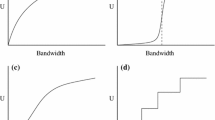Abstract
Ideally, networks should be designed to accommodate a variety of different traffic types, while at the same time maximizing its efficiency and utility. Network utility maximization (NUM) serves as an effective approach for solving the problem of network resource allocation (NRA) in network analysis and design. In existing literature, the NUM model has been used to achieve optimal network resource allocation such that the network utility is maximized. This is important, since network resources are at premium with the exponential increase in Internet traffic. However, most research work considering network resource allocation does not take into consideration key issues, such as routing and delay. A good routing policy is the key to efficient network utility, and without considering the delay requirements of the different traffic, the network will fail to meet the user’s quality of service (QoS) constraints. In this paper, we propose a new NUM framework that achieves improved network utility while taking into routing and delay requirements of the traffic. Then, we propose a decomposition technique-based algorithm, D-NUM, for solving this model efficiently. We compare our approach with existing approaches via simulations and show that our approach performs well.
Similar content being viewed by others
References
Kelly F.P., Maulloo A., Tan D.: Rate control for communication networks: shadow prices, proportional fairness and stability. J. Oper. Res. Soc. 49(3), 237–252 (1998)
Lan, T., Lin, X., Chiang, M., Lee, R.: How bad is suboptimal rate allocation? In: IEEE INFOCOM, Phoenix, AZ, pp. 321–325 (2008)
Xu D., Li Y., Chiang M., Calderbank A.R.: Elastic service availability: utility framework and optimal provisioning. IEEE J. Sel. Areas Commun. 26(6), 55–65 (2008)
Li, Y., Chiang, M., Calderbank, A. R.: Congestion control in networks with delay sensitive traffic. In: IEEE Globecom, Washington, DC, pp. 2746–2751 (2007)
Li Yi., Chiang M., Calderbank A.R., Diggavi S.N.: Optimal rate-reliability-delay tradeoff in networks with composite links. IEEE Trans. Commun. 57(5), 1390–1401 (2009)
Park D.: Network utility maximisation scheduling in mesh networks. Electron. Lett. 43(22), 1217–1219 (2007)
Lee J., Chiang M., Calderbank A.R.: Jointly optimal congestion and contention control based on network utility maximization. IEEE Commun. Lett. 10(3), 216–218 (2006)
Liu, J., Yi, Y., Proutiere, A., Chiang, M., et al.: Maximizing utility via random access without message passing, Technical Report, Sep. (2008)
Fischione C., D’Angelo M., Butussi M.: Utility maximization via power and rate allocation with outage constraints in Nakagami-lognormal channels. IEEE Trans. Wirel. Commun. 10, 1108–1120 (2011)
Jiang L., Walrand J.: A distributed CSMA algorithm for throughput and utility maximization in wireless networks. IEEE/ACM Trans. Netw. 18, 960–972 (2010)
Li R., Eryilmaz A., Ying L., Shroff N.B.: A unified approach to optimizing performance in networks serving heterogeneous flows. IEEE/ACM Trans. Netw (TON) 19, 223–236 (2011)
Neely, M.J.: Delay-based network utility maximization. In: IEEE INFOCOM, San Diego, CA, pp. 1–9 (2010)
Wei, E., Ozdaglar, A., Jadbabaie, A.: A distributed Newton method for network utility maximization. In: IEEE Conference on Decision and Control, Wuhan, pp. 1816–1821 (2010)
Xiong H., Li R., Eryilmaz A., Ekici E.: Delay-aware cross-layer design for network utility maximization in multi-hop networks. IEEE J. Sel. Areas Commun. 29(5), 951–959 (2011)
O’Neill, D., Akuiyibo, E., Boyd, S., Goldsmith, A. J.: Optimizing adaptive modulation in wireless networks via multi-period network utility maximization. In: IEEE ICC, Cape Town, pp. 1–5 (2010)
Srikant R.: The Mathematics of Internet Congestion Control. Birkhäuser, Boston (2004)
Low S.H., Lapsley D.E.: Optimization flow control, I: basic algorithm and convergence. IEEE/ACM Trans. Netw. 7(6), 861–874 (1999)
Boyd S., Vandenberghe L.: Convex Optimization. Cambridge University Press, New York (2004)
Conejo A.J., Castillo E., Mínguez R., García-Bertrand R.: Decomposition Techniques in Mathematical Programming. Springer, New York (2006)
Magnanti T., Ahuja R., Orlin J.: Network Flows—Theory, Algorithms, and Applications. Prentice-Hall, Englewood Cliffs (1993)
Palomar D.P., Chiang M.: A tutorial on decomposition methods for network utility maximization. IEEE J. Sel. Areas Commun. 24(8), 1439–1451 (2006)
Bertsekas D.P.: Nonlinear Programming, 2nd edn. Athena Scientific, Belmont (1999)
Author information
Authors and Affiliations
Corresponding author
Rights and permissions
About this article
Cite this article
Sun, G., Yu, H., Li, L. et al. Rate control-based framework and algorithm for optimal provisioning. Photon Netw Commun 22, 180–190 (2011). https://doi.org/10.1007/s11107-011-0318-y
Received:
Accepted:
Published:
Issue Date:
DOI: https://doi.org/10.1007/s11107-011-0318-y




